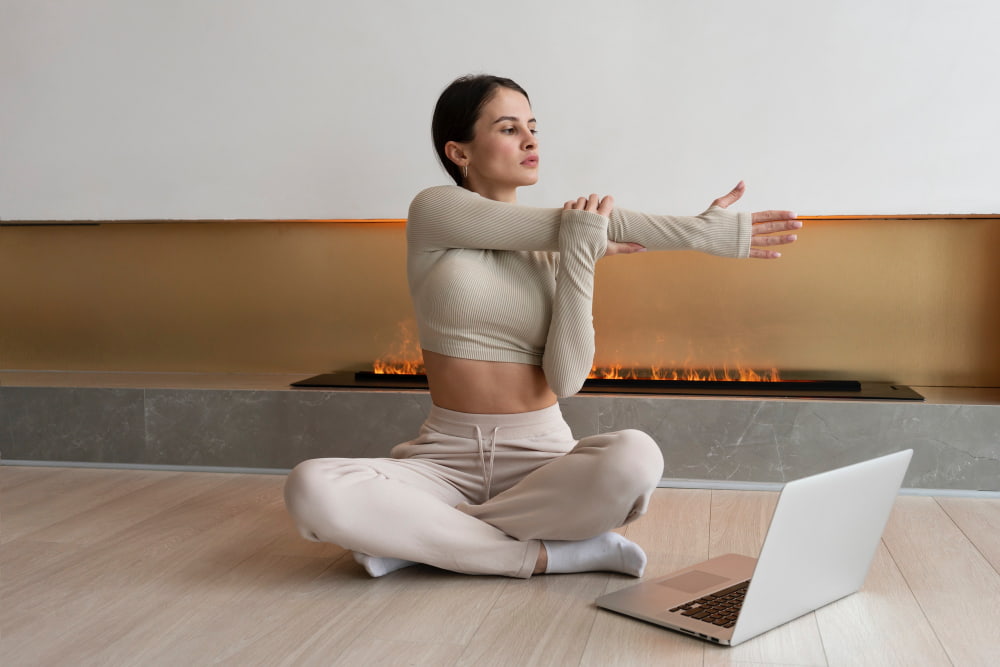
In the fast-paced world of modern work, where long hours spent sitting at a desk have become the norm, maintaining a correct posture for sitting at a desk is crucial for overall well-being. Enter BLiiNK, the innovative posture assistant revolutionizing how people maintain good posture throughout their workday.
So, what is correct sitting posture, and why is it essential? Good posture refers to the proper alignment of the body while sitting or standing, maintaining the spine's natural curves. It is not just about looking poised and confident; it plays a significant role in keeping overall health and preventing various ailments. The significance of proper sitting posture cannot be overstated for those who spend extended hours seated at their desks.
BLiiNK is an intelligent solution to help users achieve and maintain an optimal sitting position. How does it work? This innovative tool uses advanced technology to measure the angle you sit and monitor your distance from the computer. BLiiNK sends you smart notifications by analyzing your sitting habits, reminding you to adjust your posture and maintain the ideal distance from the screen.
Posture Matters: Why Proper Sitting Is a Game Changer
The benefits of maintaining a correct sitting posture are numerous. Firstly, it helps prevent back pain, one of the most common complaints among office workers. By aligning the spine correctly, good posture reduces strain on the back muscles, promoting a healthier and more comfortable sitting. Also, proper posture improves blood circulation, relieves fatigue, and increases productivity during long work sessions.
Moreover, adopting a correct sitting position can significantly reduce the risk of developing musculoskeletal issues, such as arthritis. BLiiNK empowers users to take proactive steps towards preserving their long-term health by avoiding excessive stress on joints and bones.
Correct sitting posture offers a multitude of benefits that encompass physical comfort, improved circulation, heightened productivity, and long-term health preservation. With BLiiNK by our side, we can make positive changes to our sitting habits, embrace good posture, and experience its transformative effects on our overall well-being. By investing in our sitting posture today, we pave the way for a healthier and more comfortable future, both at work and in our daily lives.
So, let’s explore the benefits of maintaining correct correct sitting posture through the work:
1. Decrease Strain On the Body
Sitting for an extended period can put a lot of strain on your body. Not only is it challenging to maintain good desk posture, but it can also lead to different types of health problems. By keeping your sitting habits healthy, you'll not only reduce the strain on your body, but you'll also have more energy and less pain.
The good news is that by being mindful of our sitting habits and making adjustments, we can significantly reduce the strain on our bodies. Incorporating short breaks and stretching exercises into our daily routine can help alleviate muscle tension and improve blood flow.
2. Reduces Wear and Tear
Sitting in a good posture can help reduce the wear and tear on your body. Many people have poor sitting habits, leading to pain, fatigue, and even health problems.
Additionally, poor sitting habits can cause fatigue and reduced energy levels. When our bodies are not in alignment, it can put unnecessary stress on our muscles, making them work harder to support us. As a result, we may feel tired and drained, even after relatively low-intensity tasks.
3. Reduce Muscle Strain
Sitting for long periods is a common aspect of modern lifestyles, especially for those with desk-bound jobs or sedentary activities. Unfortunately, prolonged sitting can lead to muscle strain, which can have detrimental effects on our bodies. A muscle strain occurs when muscles are subjected to excessive tension or overuse, leading to microscopic tears in the muscle fibers.
Aside from localized pain and fatigue, muscle strain can also lead to stiffness and reduced flexibility. The affected muscles may become tight and less pliable, making it challenging to move freely and comfortably.
The best way to avoid muscle strain is to sit with your spine straight and your back supported by your ergonomic chair. Ensure that your legs are bent at the knee and your feet are flat on the ground.
4. Improves Spine Health
You can improve your spine health if you have the correct way of sitting. A good sitting posture plays a vital role in promoting the well-being of our spine. Maintaining proper alignment while sitting allows the spine to move naturally within its intended range of motion. This natural movement is crucial for spinal health, as it helps to distribute pressure and load evenly across the vertebrae, discs, and surrounding structures.
Remember, maintaining proper posture is not just a matter of comfort or aesthetics but a fundamental aspect of cultivating a healthy, pain-free lifestyle. So, let's take a proactive approach to our sitting habits, embracing good posture and reaping its numerous benefits. With Bliink as our steadfast companion in this endeavor, we can look forward to a healthier, more productive, and pain-free work environment.
Recommended reading: Healthy Workplace Unlocked: 16 Wellness Tips for Employees
Straighten Up: Understanding the Impact of Poor Posture on Health
Incorrect posture can lead to numerous health problems. Posture problems can start as early as childhood, leading to serious issues such as chronic neck, shoulder, and even low back pain. Poor posture can lead to early health problems if you're not careful. Here are 8 dangers of poor posture on your back and health:
1. Back pain
When we slouch or hunch forward, it strains the muscles and ligaments, leading to discomfort and long-term pain. Over time, this persistent pain can interfere with daily activities and diminish the overall quality of life.
2. Poor Blood Circulation
Slumping or sitting in awkward positions can impede blood flow to various body parts, reducing oxygen supply to muscles and organs. As a result, you may experience tingling sensations, numbness, or cold extremities. Over time, poor circulation can contribute to developing more serious health conditions.
3. Impaired Lung Function
The lungs can also suffer due to improper sitting stances. When we slouch, the chest cavity becomes compressed, limiting the expansion of the lungs during breathing. This restricted lung function can lead to shallow breathing and decreased oxygen intake, negatively affecting respiratory health.
4. Poor Digestion
When we sit with a hunched posture, the organs in the abdomen may become compressed, hindering the digestive process. Consequently, you might experience indigestion, bloating, and discomfort after meals.
5. Constricted Nerves
They are another risk associated with poor posture. Incorrect alignment of the spine and muscles can put pressure on nerves, leading to a tingling or numbing sensation in the affected areas. This can be particularly troublesome if the nerves affected control vital functions or sensitive regions of the body.
6. Misaligned Spine
When the spine is not properly aligned, it can lead to various musculoskeletal issues, including back pain, sciatica, and even herniated discs. The longer you avoid the right posture for sitting, the more significant the risk of long-term spinal problems.
Recommended reading: Prevention of Sciatica: The Ultimate Guide to Defence and Relief
7. Headache and Jaw Pain
Slumping can strain the neck and upper back muscles, leading to tension headaches. Also, poor posture can cause jaw misalignment, contributing to temporomandibular joint (TMJ) pain and discomfort.
8. Poor Sleep
An incorrect sleeping position or the cumulative effects of bad posture throughout the day can lead to disrupted sleep patterns and inadequate rest. As a result, you may wake up feeling fatigued and experience daytime drowsiness.
Addressing these dangers and proactively improving posture is crucial. One innovative solution that can assist in this struggle is BLiiNK, an advanced posture assistant designed to help individuals achieve and maintain proper sitting positions.


BLiiNK: The Virtual Posture Coach for Improved Well-being
Do you find maintaining a good seated posturechallenging throughout the day?
BLiiNK uses innovative technology and science to monitor body alignment and distance from the computer, providing real-time feedback and reminders to adjust posture throughout the day. By incorporating BLiiNK into your daily routine, you can take proactive steps towards improving your posture and minimizing the risks associated with poor sitting habits, keeping a healthier and more comfortable work environment.
How does BLiiNK work?
BLiiNK uses advanced sensors to measure the angle you position yourself accurately and monitors the distance between you and your computer. With this information, BLiiNK can offer timely notifications, reminding you to adjust your posture and maintain the ideal distance from the screen. It discreetly tracks your movements, offering gentle reminders whenever your posture slips out of the recommended range.
Is BLiiNK easy to use?
Absolutely! BLiiNK is designed to be user-friendly and adaptable to your lifestyle. With its intuitive interface and personalized features, Bliink ensures you effortlessly integrate it into your daily routine without disruptions.
Can BLiiNK help with long-term health benefits?
Yes, indeed! BLiiNK goes beyond just offering reminders; it actively supports your health in general. BLiiNK helps prevent and lessen chronic pain associated with poor posture by promoting proper sitting habits.
What about exercises and tips for better posture?
BLiiNK has got you covered! Check BLiiNK’s blog to find out office desk exercises and tips tailored to your specific needs. These exercises focus on strengthening core muscles, enhancing flexibility, and promoting better posture habits. With Bliink's guidance, you can actively work towards improving your posture over time and enjoy lasting benefits for your health.
Posture Perfect: 5 Major Sitting Positions for Optimal Health
Posture is undeniably one of the most critical aspects of maintaining overall health and well-being. Good posture not only promotes a confident and poised appearance but also plays a significant role in reducing the risk of chronic diseases such as heart disease, stroke, and cancer.
To achieve and maintain perfect sitting posture, five main types of sitting positions are particularly beneficial:
Cross-Legged
As surprising as it may seem, the cross-legged position is considered among the healthiest because they allow the spine and hips to rest in a neutral position. Sitting in this manner encourages good posture by naturally pulling your shoulders and chest downward towards your sit bones.
Lotus Position (Great For Pelvis)
Often called the "king of postures," the position stretches the spine and puts gentle pressure on the discs in your back, helping to maintain its natural curve. Additionally, the position opens up your chest, facilitating easier breathing and overall relaxation.


Seated with Spine Erect
This position may only sometimes feel like the ideal sitting position, but it is undoubtedly the best way to ensure good posture. Slouching curves the spine forward and pulls the head and neck backward, which can lead to back, neck, and shoulder pain. To maintain good posture, make it a habit to sit with your spine erect and your chin slightly tucked in.
Standing with Weight on the Heels
It provides several benefits for good posture while increasing pressure on the Achilles tendon, one of the body's strongest muscles, improving strength and reducing injury risk. Additionally, this stance enhances balance, stability, and engagement of various muscle groups, contributing to better overall posture.
90-90-90 Rule
This guideline pertains to the angles formed by your hips, knees, and ankles. Ensure that your hips, knees, and ankles are all positioned at approximately 90-degree angles. This practice assists in evenly distributing your body weight and alleviating pressure on particular joints.
Incorporating these 5 major ways of sitting into your daily routine and lifestyle can significantly contribute to maintaining good posture. By being mindful of your body's alignment and making these adjustments, you can enjoy the benefits of improved posture, reduced discomfort, and a healthier, more vibrant life.
Key Findings
Are you seeking ways to boost productivity? Explore BLiiNK for valuable tips! We offer advice on enhancing efficiency, time management, and helpful resources to help you accomplish your health goals. Proper posture while sitting can significantly reduce the risk of chronic diseases and improve health. BLiiNK revolutionizes how people maintain good posture throughout their workday. Using advanced sensors and technology, BLiiNK provides real-time feedback and reminders to adjust posture to achieve correct posture while sitting.
Proper sitting posture reduces back pain, improves blood circulation, and increases productivity during long work sessions. Good posture habits can also prevent musculoskeletal issues, making BLiiNK a valuable tool for long-term health benefits. So why not give us a free try !

